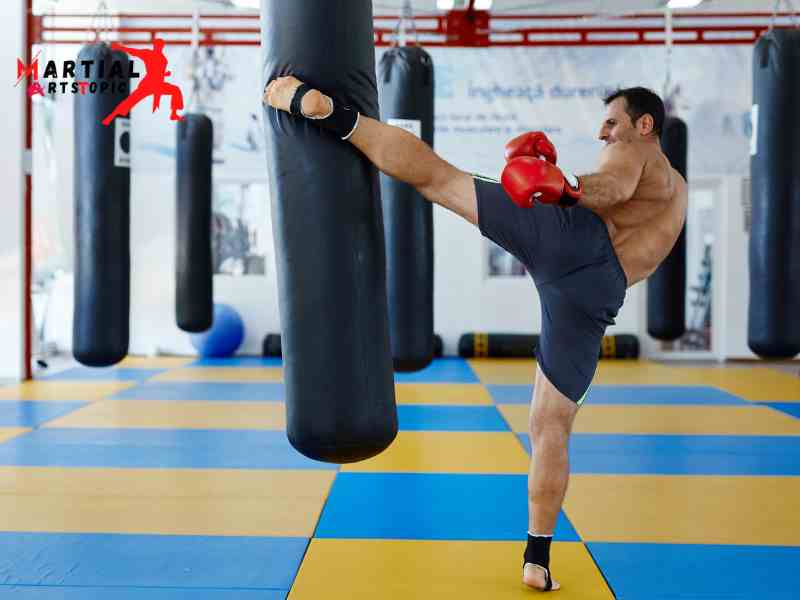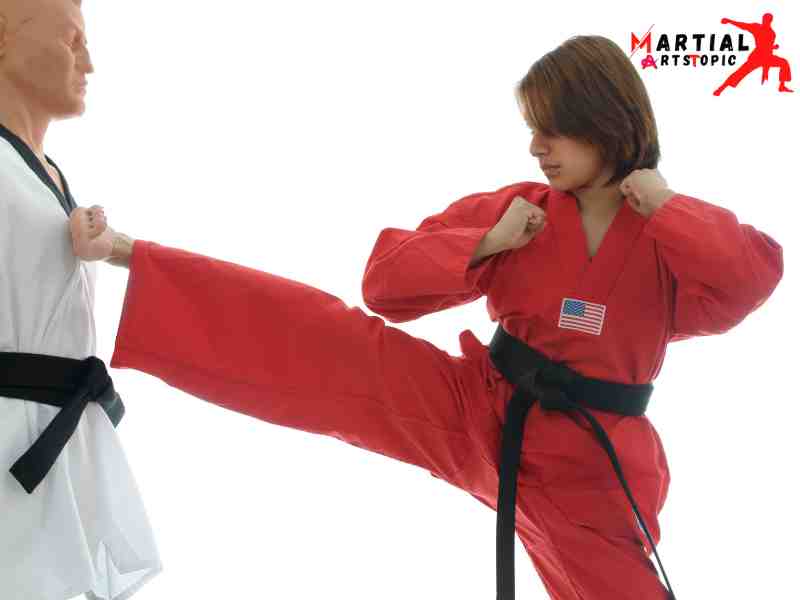
The Power and Purpose of Kickboxing
The Power and Purpose of Kickboxing. Are you looking for an exhilarating workout that not only strengthens your body but also empowers your mind? Look no further than kickboxing! Kickboxing is a dynamic and high-energy martial art that combines elements of boxing and karate. In this blog post, we will explore the power and purpose of kickboxing and how it can help you unleash your inner warrior.
What is Kickboxing?
What is Kickboxing? Kickboxing is a dynamic and high-energy martial art that combines elements of boxing and various kicking techniques. It is a fantastic way to improve cardiovascular fitness, agility, and overall strength. Kickboxing also offers practical self-defense skills, making it a popular choice for those seeking both physical and mental empowerment. Whether you’re looking to tone your body, learn self-defense, or simply blow off some steam, kickboxing provides an exhilarating and effective workout that caters to people of all fitness levels. With its roots in traditional martial arts, kickboxing has developed into a modern and exciting sport that continues to inspire and challenge practitioners around the world.
The Power of Kickboxing

What is Kickboxing? Kickboxing is not just about throwing punches and kicks; it is a full-body workout that engages multiple muscle groups simultaneously. When you engage in kickboxing, you’ll be working on your arms, legs, core, and cardiovascular system. It is a highly effective way to build strength, improve endurance, and burn calories. In fact, they have shown kickboxing to burn up to 750 calories per hour!
Kickboxing also helps to improve coordination, balance, and flexibility. The fast-paced nature of the sport requires you to move quickly and fluidly, which enhances your overall coordination and agility. The various kicks and punches performed in kickboxing require a wide range of motion, leading to improved flexibility.
The Purpose of Kickboxing
Aside from its physical benefits, kickboxing also holds immense psychological benefits. Kickboxing is a powerful stress reliever and a great way to release pent-up energy and frustrations. When you engage in kickboxing, you can punch and kick your way to a clearer mind and a more relaxed state.
Kickboxing teaches you discipline, focus, and perseverance. The rigorous training and constant practice required in kickboxing help develop mental toughness and resilience. As you progress in your kickboxing journey, you’ll learn to push through challenges and overcome obstacles, both in the ring and in life.
The History and Evolution of Kickboxing: From Ancient Origins to Modern Sport
The History and Evolution of Kickboxing: From Ancient Origins to Modern Sport kickboxing is a dynamic and exhilarating combat sport that combines elements of martial arts like karate, Muay Thai, and boxing. Over the years, kickboxing has gained immense popularity worldwide, captivating both athletes and spectators with its high intensity and skillful techniques. In this blog post, we will delve into the rich history and evolution of kickboxing, tracing its roots back to ancient times and exploring how it has transformed into the modern sport we know today.
Ancient Origins: The Birth of Hand-to-Hand Combat
We can trace the origins of kickboxing back to ancient civilizations, where hand-to-hand combat was a crucial skill in warfare and personal protection. In ancient Greece, kickboxing known as pankration was practiced. This style combined striking and grappling techniques, allowing fighters to use their fists, feet, and even chokeholds to overcome their opponents.
Similarly, in ancient India, a martial art called Vajra Mushti was developed, which involved strikes with closed fists and open-handed techniques. Vajra Mushti laid the foundation for modern kickboxing techniques and emphasized the importance of agility, speed, and accuracy in combat.
Muay Thai: The Art of Eight Limbs
One of the most influential martial arts in kickboxing’s evolution is Muay Thai, also known as the “Art of Eight Limbs.” Originating in Thailand, Muay Thai practitioners incorporate punches, kicks, knee strikes, and elbow strikes into their fighting style. This ancient martial art has been practiced for centuries and has had a significant impact on the development of modern kickboxing.
Western Influence: The Birth of American Kickboxing
In the 1960s and 1970s, American martial artists began experimenting with integrating different striking techniques from various martial arts disciplines. This led to the birth of American kickboxing, which combined elements of karate and boxing. The sport garnered attention and popularity, especially after they held the first official kickboxing match in the United States in 1970.
International Recognition: The Rise of Kickboxing as a Global Sport
In the 1980s, kickboxing gained international recognition as a competitive sport. They established various organizations to regulate and promote the sport, such as the International Kickboxing Federation (IKF) and the World Kickboxing Association (WKA). Kickboxing tournaments and events began attracting a large audience, showcasing the skill, power, and agility of the athletes.
Modern Kickboxing: A Blend of Tradition and Innovation

Today, kickboxing continues to develop and thrive as a popular combat sport. The sport has diversified into different styles, including full-contact, light-contact, and low-kick kickboxing. They commonly practiced it as fitness training, combining cardio exercises with striking techniques.
Kickboxing has not only become a sport, but also a way of life for many enthusiasts around the world. It promotes discipline, fitness, and self-confidence while providing a platform for athletes to showcase their skills in a competitive setting.
Getting Started with Proper Techniques and Training
Getting Started with Proper Techniques and Training in Kickboxing are you curious about what kickboxing is? Whether you’re a fitness enthusiast looking for a new and exciting workout or someone interested in learning self-defense, kickboxing is a fantastic martial art to consider. In this blog post, we will explore the world of kickboxing, its benefits, and how to get started with proper techniques and training.
Benefits of Kickboxing
- Full-Body Workout: Kickboxing engages multiple muscle groups, providing a complete workout for your upper body, lower body, and core. It helps you burn calories, tone muscles, and improve overall body strength.
- Cardiovascular Fitness: The fast-paced nature of kickboxing elevates your heart rate, improving cardiovascular endurance and stamina.
- Stress Relief: Kickboxing serves as an excellent stress reliever. The intense physical activity helps release endorphins, which boost mood, reduce stress, and increase overall mental well-being.
- Self-Defense: Learning kickboxing techniques can equip you with valuable self-defense skills, giving you the confidence to protect yourself if ever faced with a threatening situation.
Getting Started with Kickboxing
- Find a Qualified Instructor: Look for a reputable kickboxing gym or martial arts studio in your area. Ensure that the instructors are experienced, certified, and knowledgeable in kickboxing techniques.
- Start Slow: If you’re new to kickboxing, it’s important to start slow and gradually increase intensity. Begin with beginner-level classes or private sessions to learn the basic techniques and build a solid foundation.
- Learn Proper Techniques: The proper technique is crucial in kickboxing to maximize effectiveness and minimize the risk of injury. Pay close attention to your instructor’s guidance and practice the correct form from the beginning.
- Focus on Conditioning: Kickboxing requires strength, flexibility, and endurance. Incorporate regular strength training, cardiovascular exercises, and flexibility exercises into your routine to improve your overall performance.
- Stay Consistent: Like any martial art, mastering kickboxing takes time and practice. Stay consistent with your training, attend classes regularly, and dedicate time for additional practice outside of class.
Kickboxing for Self-Defense: Basic Techniques in Kickboxing
Kickboxing for Self-Defense: Mastering Basic Techniques in Kickboxing. Are you looking for an empowering way to stay fit while learning valuable self-defense skills? Look no further than kickboxing! In this blog post, we will explore the fundamentals of kickboxing and how it can be an effective form of self-defense. So, lace up your gloves and get ready to unleash your inner warrior!
Basic Techniques in Kickboxing
- Punches: One of the fundamental techniques in kickboxing is throwing punches. Mastering the proper punch technique is crucial for generating power and accuracy. Common punches in kickboxing include jabs, hooks, uppercuts, and crosses. It can execute these punches from various angles, allowing for effective strikes in different situations.
- Kicks: Kicks are another essential component of kickboxing. They provide a longer range of attack and can keep opponents at bay. Some common kicks in kickboxing include front kicks, roundhouse kicks, sidekicks, and spinning back kicks. By practicing these kicks, you will develop flexibility, balance, and leg strength.
- Footwork: Effective footwork is key to maneuvering in kickboxing. By mastering footwork techniques, such as pivoting, shuffling, and sidestepping, you can create angles to attack or defend. Proper footwork also enables you to maintain balance and avoid being a stationary target.
- Defense: In kickboxing, defense is just as important as offense. Techniques like blocking, parrying, and evading help protect yourself from incoming strikes. By honing your defensive skills, you can avoid being hit and create opportunities for counterattacks.
- Conditioning: Kickboxing is a physically demanding sport that requires endurance, stamina, and strength. Conditioning exercises such as shadowboxing, bag work, and pad drills help build your cardiovascular fitness and muscular endurance. Regular training will improve your overall physical fitness and ensure you can hold your own in a self-defense situation.
- Knee Strikes: Another unique aspect of kickboxing is the utilization of knee strikes. This close-range technique can be devastating if executed correctly. Knee strikes can target an assailant’s groin, abdomen, or face, providing an effective means of self-defense.
Kickboxing for Self-Defense
Kickboxing is not only a great way to stay fit, but also an effective form of self-defense. By learning the basic techniques, you can develop the skills needed to protect yourself in real-life situations. The combination of punches, kicks, footwork, and defensive maneuvers provides a comprehensive toolkit to ward off potential threats.
Remember, self-defense is not just about physical techniques. Kickboxing also teaches discipline, mental focus, and self-confidence. By training in this martial art, you will develop a strong sense of self-awareness and the ability to stay calm under pressure.
Different Styles of Kickboxing
Different Styles of Kickboxing: Exploring the Exciting World of Martial Arts kickboxing, a high-intensity combat sport, has gained immense popularity worldwide. It combines elements of boxing and martial arts, making it a thrilling and challenging sport for both athletes and enthusiasts. In this blog post, we will delve into the different styles of kickboxing and summarize what kickboxing is all about.
Styles of Kickboxing
- American kickboxing is one of the most popular styles of kickboxing in the United States. It focuses on powerful punches, kicks, and knee strikes, emphasizing both offensive and defensive techniques. American kickboxing competitions often take place in a ring, with fighters donning gloves and protective gear.
- Muay Thai, also known as Thai boxing, originated in Thailand and is considered the national sport of the country. We know it for its devastating strikes using fists, elbows, knees, and shins. Muay Thai practitioners are renowned for their strength, conditioning, and striking prowess. This style also allows clinching, which involves grappling techniques.
- Dutch kickboxing, also called the “Art of Eight Limbs,” is a style that originated in the Netherlands. It combines traditional kickboxing techniques, focusing strongly on low kicks and knee strikes. We know dutch kickboxing for its aggressive and relentless fighting style, with fighters often pushing the pace and constantly pressing forward.
- Savate, also known as French kickboxing, is a unique style that originated in France. It incorporates both hand strikes and kicks, with a specialization in powerful and precise kicks. Savate practitioners wear specialized footwear, allowing for swift and accurate kicking techniques. This style emphasizes footwork, agility, and strategic positioning.
- Sanshou, also known as Sanda, is a Chinese style of kickboxing that combines elements of traditional Chinese martial arts with modern combat techniques. It focuses on both striking and throws, making it a versatile and well-rounded style. Sanshou competitions often take place in a ring, with fighters showcasing their skills in both stand-up and takedown techniques.
So, if you’re ready to step into the world of kickboxing, find a local gym or studio that offers classes in one of these exciting styles. Remember to start slowly, focus on proper technique, and always prioritize safety. Kickboxing is not only a great sport but also a fantastic way to boost your fitness levels and gain self-confidence. Embrace the challenge and enjoy the exhilarating journey that kickboxing offers.
Kickboxing Equipment and Gear
Kickboxing Equipment and Gear: A Complete Guide to What You Need are you curious about kickboxing? Wondering what equipment and gear are necessary to get started? Look no further! In this comprehensive guide, we will walk you through everything you need to know about kickboxing equipment, from gloves and pads to clothing and footwear. So, let’s dive right in and explore the world of kickboxing!
Essential Kickboxing Gear
- Kickboxing Gloves: in kickboxing, gloves are a must have. They protect your hands and knuckles from injuries and provide support during punches. Opt for high-quality gloves that offer proper padding and a secure fit.
- Hand Wraps: Hand wraps are crucial in kickboxing. They provide extra support to your wrists and help prevent injuries. Wrapping your hands properly before putting on gloves is essential to ensure a safe and comfortable training session.
- Kickboxing Pads: they used Kickboxing pads for practicing various strikes and combinations. They come in different sizes and shapes, including focus mitts, Thai pads, and shields. Pads allow you to practice strikes with a partner, enhancing your precision and power.
- Mouth guard: Protecting your teeth and jaw is essential in any combat sport. A well-fitting Mouth guard reduces the risk of dental injuries during intense training sessions or sparring matches.
- Shin Guards: Kickboxing involves powerful kicks, so investing in shin guards is crucial. Shin guards protect your shins and lower legs from affects and minimize the risk of injuries during training.
- Groin Guard: For male kickboxers, a groin guard is a vital piece of protective gear. It offers crucial protection in a vulnerable area and ensures a safe training environment.
- Training Apparel: Comfortable and breathable clothing is essential for kickboxing. Opt for moisture-wicking fabrics that allow freedom of movement. Consider investing in kickboxing shorts or leggings specifically designed for the sport.
- Footwear: While they often practice kickboxing barefoot, some gyms may require specialized shoes. These shoes offer better grip and support, especially during intense training sessions or on different surfaces.
Besides these essential items, you may also consider adding additional gear such as headgear, knee pads, and elbow pads, depending on your training goals and preferences.
Where to Find Kickboxing Equipment

Now that you know what equipment and gear you need for kickboxing, you may wonder where to find them. You can check out local sports stores, martial arts supply shops, or browse online for a wide selection of kickboxing gear. Choose reputable brands that prioritize quality and safety.
Remember, safety should always be your top priority. Invest in high-quality gear, maintain proper technique, and train under the guidance of qualified instructors. Whether you’re a beginner or an experienced practitioner, kickboxing equipment and gear will be your best companions on your journey to becoming a kickboxing champion!
Benefits of Kickboxing
Benefits of Kickboxing: What You Need to Know kickboxing is a dynamic and high-energy combat sport that combines elements of boxing and martial arts. It originated in Japan and gained popularity worldwide because of its many benefits for the mind, body, and overall well-being. In this blog post, we will explore the incredible benefits of kickboxing and why you should incorporate it into your fitness routine.
- Total Body Workout: Kickboxing is an excellent way to get a full-body workout. By engaging your arms, legs, core, and cardiovascular system, kickboxing helps you burn calories, build muscle strength, and improve your overall endurance. From punches to kicks, every movement in kickboxing targets different muscle groups, resulting in a toned and sculpted physique.
- Cardiovascular Fitness: Kickboxing is a highly aerobic activity that gets your heart pumping. Regular kickboxing sessions can improve your cardiovascular fitness, increase your lung capacity, and enhance your overall stamina. The fast-paced nature of kickboxing helps you elevate your heart rate, burn fat, and improve your overall cardiovascular health.
- Stress Relief: Kickboxing serves as a fantastic stress buster. The combination of physical exertion and mental focus allows you to release pent-up stress and tension. As you throw punches and kicks, you let go of negative energy, leaving you feeling refreshed and rejuvenated. Kickboxing also stimulates the release of endorphins, known as “feel-good” hormones, which further improves your mood and reduce stress levels.
- Self-Defense Skills: Learning kickboxing not only helps you get fit, but also equips you with essential self-defense skills. Kickboxing teaches you how to strike and defend yourself effectively, enhancing your confidence and personal safety. Knowing that you can protect yourself in a potentially dangerous situation can significantly boost your self-esteem and empower you in all areas of life.
- Improved Coordination and Balance: Kickboxing requires coordination, balance, and agility. By consistently practicing kickboxing techniques, you can enhance your hand-eye coordination, footwork, and overall body control. These improvements can have a positive impact on other physical activities and sports, making you more agile and less prone to injuries.
- Mental Focus and Discipline: Kickboxing requires mental focus and discipline to execute precise techniques and combinations. Regular training in kickboxing helps sharpen your concentration and enhance your mental clarity. The discipline instilled in kickboxing can transcend into other aspects of your life, such as work or personal goals, improving your productivity and success.
- Weight Loss and Body Toning: If weight loss is your goal, kickboxing can be a highly effective tool. With its combination of high-intensity cardio and strength training, kickboxing helps you burn calories and shed unwanted pounds. Kickboxing builds lean muscle mass, which boosts your metabolism and helps you maintain a healthy weight in the long run.
Kickboxing for Self-Defense: Empower Yourself with Essential Skills
Kickboxing for Self-Defense: Empower Yourself with Essential Skills in today’s unpredictable world, it’s essential to equip yourself with the skills to defend yourself. Kickboxing, a dynamic and empowering martial art, can provide you with the tools you need to protect yourself and boost your self-confidence. In this blog post, we will explore what kickboxing is and how it can be an effective form of self-defense.
So, what is kickboxing? Kickboxing is a combat sport that combines elements of boxing and karate, incorporating punches, kicks, knee strikes, and elbow strikes. It is a high-intensity, full-body workout that not only strengthens your muscles but also enhances your agility, coordination, and cardiovascular endurance. Kickboxing training involves various techniques and drills that simulate real-life combat situations, making it an ideal choice for self-defense.
One of the main advantages of kickboxing for self-defense is its focus on striking techniques. By learning how to deliver powerful punches and kicks, you can effectively defend yourself against potential attackers. Kickboxing enables you to generate force from your entire body, allowing you to strike with both speed and power. This combination of strength and technique can give you a significant advantage in a confrontational situation.
Kickboxing training teaches you how to maintain a strong and balanced stance, which is crucial for self-defense. By improving your balance and footwork, you can evade attacks and maintain control of the situation. Kickboxing also emphasizes the importance of situational awareness, teaching you how to expect and react to potential threats effectively.
Another benefit of kickboxing for self-defense is its focus on conditioning and fitness. Regular kickboxing workouts improve your overall physical fitness, strengthening you, faster, and more agile. This increased fitness level can significantly enhance your ability to defend yourself, as it allows you to react quickly and perform techniques with precision.
Kickboxing offers an excellent opportunity for stress relief and empowerment. Training in kickboxing provides a healthy outlet for releasing pent-up energy and frustration, helping you manage stress effectively. The sense of empowerment that comes from mastering new skills and techniques can boost your self-confidence, making you less vulnerable and more assertive in potentially dangerous situations.
In self-defense, proper training and guidance are essential. It’s crucial to find a reputable kickboxing school or trainer who can teach you the techniques and ensure your safety during training. With the right instruction, you can learn how to effectively defend yourself while minimizing the risk of injury.
From the Ring to the Gym: How Kickboxing Can Help You Stay Fit

From the Ring to the Gym: How Kickboxing Can Help You Stay Fit Are you looking for a fun and effective way to stay fit? Look no further than kickboxing! Kickboxing is a high-intensity workout that combines martial arts techniques with cardio exercises. Not only does it give you a fantastic full-body workout, but it also helps improve your strength, flexibility, and overall cardiovascular health. In this blog post, we will explore what kickboxing is, its benefits, and how it can help you achieve your fitness goals.
So, what exactly is kickboxing? Kickboxing is a combat sport that originated in the 1960s and has gained popularity worldwide. It involves a combination of punches, kicks, knee strikes, and elbow strikes. This dynamic martial art is not only a great way to learn self-defense techniques but also an incredible workout that engages multiple muscle groups simultaneously.
One of the primary reasons kickboxing has become a go-to fitness activity is its ability to burn calories and shed fat. By engaging in this high-intensity workout, you can torch up to 750 calories per hour, depending on your intensity level. This makes kickboxing an excellent choice for individuals looking to lose weight or maintain a healthy weight. The constant movement and quick transitions between different moves keep your heart rate up, providing an effective cardiovascular workout.
Kickboxing also offers a wide range of physical benefits. It helps improve your strength and endurance by targeting your upper body, lower body, and core muscles. Through repeated punches and kicks, you can strengthen your arms, shoulders, chest, abdominals, glutes, and legs. The constant movement and quick footwork in kickboxing enhance your agility, speed, and coordination.
Apart from the physical benefits, kickboxing is also a fantastic stress-reliever. The intense workout allows you to release pent-up energy and frustration, leaving you feeling refreshed and rejuvenated. The combination of physical exertion and mental focus required in kickboxing provides an excellent outlet for stress relief, helping you achieve a sense of calm and balance.
Kickboxing is a versatile workout that can be adapted to suit all fitness levels. Whether you are a beginner or an experienced fitness enthusiast, it can tailor kickboxing classes to meet your specific needs. Trained instructors will guide you through the proper techniques, ensuring that you perform the moves correctly and safely. Kickboxing is a great way to challenge yourself and set new fitness goals. As you progress in your training, you can learn advanced techniques and take your fitness journey to new heights.
conclusion
Kickboxing is a dynamic combat sport that combines elements of martial arts, boxing, and self-defense techniques. It offers many physical and mental benefits, including improved cardiovascular fitness, strength, flexibility, and self-confidence. Kickboxing also provides an effective means of stress relief and an opportunity for personal growth and self-discipline. Whether you are looking to enhance your fitness level, learn self-defense skills, or simply enjoy a challenging and empowering workout, kickboxing is a versatile and rewarding activity that can cater to individuals of all ages and fitness levels. So, why not step into the ring and experience the exhilaration of kickboxing for yourself?
